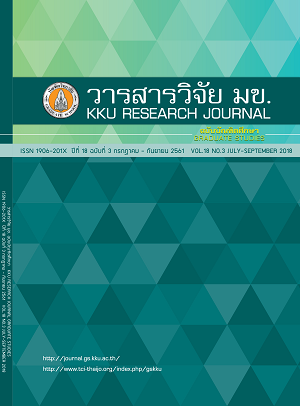The Threat for Risk Factors of Pregnancy Rreadiness among Thai Women in the Northeast
Keywords:
Threat for risky factors, Infertility, Nation pregnancy policyAbstract
Thai government has a policy for solve the problem of working women who were likely to get marriage slowly and they would not get marriage increasingly. Consequently, the birth rate were simply stable and would be decreasing. This Cross-sectional Survey Research was aimed to : 1) study the pregnancy readiness condition 2) study the risk factors for pregnancy readiness 3) study the threats of risk factors for health and pregnancy readiness of reproductive women. The sample was the 4,924 reproductive women living in the Northeast of Thailand, and they were between 20 and 34 years of age. Data were collected by questionnaires with reliability 0.79 during January to October 2017. All data were analyzed by 1) Descriptive statistics : Frequency, Percentage, Mean and Standard Deviation 2) Inferential statistics: Odds Ratio 95% CI and Multiple Logistic Regression. The results revealed that the average age of samples were 27.55 years old (S.D.=0.564). The average incomes of family were 10,809.00 Baht per month (S.D. = 7401.614). Most of them had no underlying diseases 81.0%. However, they had sexually transmitted infection 2.4 %, accident 23.8%, a history of abortion 2.4%, pregnancy readiness 36.4%. Moreover, they had an average of sexual relationship 2.61 times per week (S.D.=1.710), contraception 55.4%, and contraceptive injection 14.9% respectively. In addition, they had high level of personal relationship average with 77.09 (S.D. = 9.297), had knowledge about pregnancy readiness and belief were high level with average of 12.02 (S.D. = 2.493) and 11.07 (S.D.= 2.004) respectively. But, the attitude was low level with average of 52.35 (S.D.=5.463). The risk factors for pregnancy readiness were accident, income and frequency of sexual intercourse. The threats of risk factors for health were accident, sexually transmitted disease, and contraceptive. Besides, the threats of risk factors for pregnancy readiness factors were accident, pregnancy knowledge, and reproductive age with significant at .05 level.
References
2. National Statistical Office. Population and Housing. Bangkok: National Statistical Office; 2012. 456 p.
3. Department of Provincial Administration, Ministry of Interior. Annual Report 2016. Bangkok: Ministry of Interior; 2017. 156 p.
4. Ministry of Public Health. Annual Report 2015. Nonthaburi: Ministry of Public Health, 2016. 245 p.
5. Charoenwit T. Consult a doctor to prepare for pregnancy. Bangkok: Bumrungrad International Hospital; 2016.
6. Patibud P, Sakulchaikhon P, Palung P, TeeKaweerakit P, Bunnapasat W, Chanickoengka P. Factors Influencing to Intrauterine insemination in Naresuan University Hospital. Naresuan University Journal. 2016; 12(1): 769–785. Thai.
7. Chirawatkul A. Biostatistics for Health Science Research. 4th ed. Khon Kaen: Faculty of Public Health, Khon Kaen University; 2008.
8. Office of the National Economics and Social Development Board. Annual Report 2016. Bangkok: Office of the National Economics and Social Development Board; 2017. 113 p.
9. Miadthaisong O, Roomruangwong C, Rungruxsirivorn T. Self-esteem and associated factors among Thai female patients at Infertility Clinic, King Chulalongkorn Memorial Hospital. Chula Med J. 2016 Jul – Aug; 60(4): 413–424. Thai.
10. Srimuang J, Roomruangwong C. Marital satisfaction and associated factors among female patients in infertility clinic at King Chulalongkorn Memorial Hospital. Chula Med J. 2013; 57(5): 653-65. Thai.
11. Deejapo J, Theerakulcha J, Phumosakul S. The Relationships between Personal Factors, Stress, the Wife’s Role, Marital Relationship, and Quality of Life among Infertile Women. Journal of Phrapokklao Nursing College. 2017; 28(2) 67-79. Thai.
12. Hassan MAM, Killick SR. Effect of male age on fertility: evidence for the decline in male fertility with
increasing age. Fertility and Sterility. 2003; 79(3): 1520-1527.
13. Kamel RM. Management of the infertile couple: an evidence-based protocol. Reproductive Biology and
Endocrinology. 2010; 8(21): 1-7.
14. Lindsay TJ, Vitrikas KR. Evaluation and Treatment of Infertility. American Family Physician. 2015; 91(5): 309-314.
15. Thonneau P, Quesnot S, Ducot B, Marchand S, Fignon A, Lansac J, et al. Risk factors for female and male
infertility: results of a case-control study. Human Reproduction. 1992; 7(1): 55-58.
16. Liu K, Zhao R, Shen M, Ye J, Li X, Huang Y, et al. Role of genetic mutations in folate-related enzyme genes on
Male Infertility. Scientific Reports. 2015; 5(15548): 1-13.
17. Greil AL. Infertility and psychological distress: A critical review of the literature. Social Science & Medicine.
1997, 45(11):1679-1704.
18. Kedthongma W. Population and Maternal and Child Health. Sakon Nakhon: Kasetsart University Chalermphrakiat Sakon Nakhon Province Campus; 2014.
19. Wright J, Allard M, Lecours A, Sabourin S. Psychosocial distress and infertility: a review of controlled research. International Journal of Fertility. 1989, 34(2): 126-42.
20. Nipriyai S. Birth and Infertility. Nakhon Si Thammarat: Nakhon Si Thammarat Rajabhat University; 2009.


